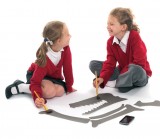Ollie Bray identifies a few ways in which ICT can enhance children's learning experience...
ICT is rapidly changing the way that we live, work and play. It’s also transforming classrooms around the UK as teachers use technology to share ideas, collaborate and, most importantly, enhance the learning experience for children. In this article we will look at some of the issues surrounding the use of ICT and some interesting activities that can easily be replicated inclassrooms, schools and education authorities.
Can you remember who taught you to search the internet? Probably not, as most teachers today taught themselves. We based our early internet searching on the wisdom that we had gained from searching libraries because we were used to thinking about key words and using them to retrieve knowledge. The problem is that we don’t search libraries like this anymore. What’s more, there is so much ‘stuff’ on the internet it’s getting more and more difficult to find anything. That’s why the ability to search the internet properly is one of the most important skills that children can learn in school. Lessons in basic ‘search’ skills provide a great opportunity for teachers to reinforce aspects of key literacy. The best lessons don’t involve getting anywhere near a computer to start with, either.
A search query is only as good as the words that you put in. Words can mean different things and different words can mean the same thing, so it’s important to get children thinking about words before they type them into Google and the like. Webquests are quite an old idea now, but they’re still a good way to get children thinking about what they’re looking for online. The basic idea of a webquest is to challenge groups of children to find information about a specific topic. The best webquests are collaborative, with each child assuming a different role or responsibility (researcher, scientist, photographer, mapper etc…). Some webquests suggest that children search within a predetermined group of sites while others are more open-ended.
If you have not tried a webquest with your class there are hundreds of examples on the internet – just Google for one (e.g. ‘webquest solar system’) and you’ll see.
One of the concerns that teachers have when facilitating lessons about searching online is that children may come across unsuitable content, including adult-only material. The reality of the situation is that the internet does contain unsuitable content, but most of this will be picked up by your school’s filtering software. That said, we do need to teach children about ‘unreliable’ content. For example, many search engines accept payment for listing links or include adverts on their results pages. Most search engines label these as ‘sponsored links’, but it’s a good idea to make sure the children in your class understand what ‘sponsored’ means and that some of these links have been paid for.
 Good teachers use good tools, and teachers have always used play in their classroom. Computer games-based learning is a natural evolution of classroom play, and teachers all around the UK are starting to use games as contextual hubs for learning to enhance the classroom experience.
Good teachers use good tools, and teachers have always used play in their classroom. Computer games-based learning is a natural evolution of classroom play, and teachers all around the UK are starting to use games as contextual hubs for learning to enhance the classroom experience.
Gavinburn Primary School in East Dunbartonshire is one school that has really embraced the concept of games-based learning. They recently did a whole unit of work on the Winter Olympics using Mario & Sonic at the Winter Olympic Games as the stimulus. Learning activities included:
• Using the Nintendo Wii and the game to gather real data that was used in maths lessons
• Learning Japanese, Russian and Norwegian from podcasts, with children creating their own language podcasts to teach their parents
• Dealing with critical incidents throughout the unit of work where children were expected to react, plan and solve a problem (this included substance abuse, snow shortage and a missing pair of speed skates)
• Imaginative writing and storytelling about their Olympic team (each class was a different country)
• Research into the history of the Winter Olympics and Olympic sports
• Collaborative working to develop a team identity and to challenge global stereotypes
• Video conferencing with a Canadian primary school to discuss the Olympics, but also to teach the children about place and time zones
The project finished with an Olympic closing ceremony where all of the children presented their work to parents and members of the wider school community.
Other games that are regularly being used across the UK to create rich environments for learning include Guitar Hero (for cross-curricular projects on music), Endless Ocean (for cross-curricular projects on marine life, seas and oceans), Wild Earth African Safari (for cross-curricular projects on Africa) and Nintendogs (for cross-curricular projects on looking after animals). Gavinburn have also been using the Sony Eye Pet for the PlayStation 3 to help with the transition of young children from the nursery school into the primary school.
As ICT pedagogy develops in schools, the one thing that’s clear is that ICT should no longer be seen as a standalone activity. Where possible, and where appropriate, it should be embedded within the teaching and learning process, and be part of the learning experience.
Children in Jen Deyenberg’s class at the Dorothy Dalgliesh School, Alberta, Canada recently read The Dinosaurs of Waterhouse Hawkins. Waterhouse Hawkins was an artist who created the first life-sized models of dinosaurs based on fossils. Some of his most famous creations are on display in Dinosaur Court in Crystal Palace, London.
After the children had read and discussed the book they had to use GPS to go out and find their own paper dinosaur bones, which their teacher had hidden in the school grounds. Back in the classroom the 10 year-olds put the bones together and produced 2D diagrams of their findings. The next stage was to use modelling clay to scale their 2D diagrams into a smaller 3D object. Student work was shared on class and individual blogs. Finally, the children took part in a video conference with school children in Louisiana, who explained some of the science behind the fossils.
This is a great example of a project that could have been completed without ICT; however, ICT adds to the experience by making the learning more exciting, relevant and real.
 ICT should be the responsibility of all teachers and this means that promoting the safe and responsible use of technology should also be the responsibility of all.
ICT should be the responsibility of all teachers and this means that promoting the safe and responsible use of technology should also be the responsibility of all.
Responsible use (or e-safety) should be embedded into the curriculum, taught and discussed with children as soon as they have access to technology at school (from 3+). Teachers should try their best to stay up-to-date with emerging technology developments and trends. A good place to start and a good place for resources is the teachers’ area of CEOP’s Thinkuknow website. (You’ll find more on e-safety from page 78 – Ed.)
 Display children’s work beyond the classroom…
Display children’s work beyond the classroom…
You’ve heard of the World Wide Web, but have you heard of the world wide wall display? Actually, they’re the same thing. The internet can provide an additional audience for students’ work, and this can be very empowering to young people. There are a number of ways that you can do this:
Blogs
Blogs are really easy-to-edit websites. They are either free to set up or very cheap. Green Park Primary School in Liverpool has a fantastic school blog/website where every class has its own individual page. Embedded in the pages are examples of students’ work, from paintings to poetry, PowerPoint presentations to videos. The best thing about Green Park’s blogs are the hundreds of comments from parents, other children and the wider school community who all encourage the children and comment on their work.
Podcasts
Podcasts are audio or video recordings that you can subscribe to, and they’re really easy to make (just ask the children in your class!). Law Primary School in East Lothian makes regular podcasts with its upper primary classes to help them learn French. Children practise their vocabulary, sing songs and have fun learning a second language. Just like the Green Park blogs there are always lots of comments and encouragement from the wider school community.
Internet TV
Websites like YouTube, Blip TV and Vimeo mean that all schools can now have their very own television station if they want to. Web television is a great way to showcase work and live broadcast from your classroom. Wheeler Primary School in Hull has produced a number of great animations and puppet shows in collaboration with Creative Partnerships Hull. My favourite is the Y1 version of Jack and the Beanstalk that has been published on YouTube.
Wikis
Wikis are really easy-to-edit websites. The most famous is Wikipedia, which is the largest encyclopedia in the world. Anyone can edit Wikipedia, which makes it a great place for children to publish information about their local area. Think about working with your class and writing a Wikipedia article on your school or local area, or seeing if you can improve the one that already exists. Both of these activities are a really good way to develop critical literacy skills with children and young people.
Banish the novelty ringtones and put children’s mobiles to good use in school…
There is certainly educational mileage in allowing children to use mobile phones in the classroom – as long as they use them responsibly, and the school and teacher have some sort of technology policy, obviously. Whilst the ubiquitous calculator functionality has obvious applications, it’s when it comes to outdoor learning in particular, they can really prove an invaluable aid to students.
App-propriate content
There are a growing number of apps for the likes of Apple’s iPhone, Windows 7 Mobile devices and those running Google’s Android that are appropriate for use in school. Useful apps include iPhone notebook, Google Maps and Satellite View (both built-in), Ordnance Survey Maps, Built in GPS for Google Earth Exports and Evernote (an electronic fieldwork notebook) is worthy of consideration – and this is just scratching the surface.
These examples stand-out because they give children a real chance to send data back from the field and compile fieldwork reports as they go. GPS functionality, in particular, shouldn’t be underestimated as an educational tool.
You might also like to consider:
• Mobile blogging apps – e.g. Typepad, Blogger and Wordpress
• Other fieldwork apps – e.g. clinometer, compass etc.
• Audioboo – a mobile/web platform for sharing audio
• Speak and Spell – a tried and test literacy aid
Going back in time
Another area to consider is the idea of Augmented Reality. By way of example, The Museum of London has produced a Street Museum app, which enables children to visit a selection of London locations, hold up their phones and enjoy images from the 1940s, or artwork from earlier periods, over real-time images of the present day. Clearly this is not something that could be utilised everyday, but its potential, both for directed outdoor learning and independent learning, is clear to see.
Some good children-friendly search engines include:
• Yahoo for kids: http://kids.yahoo.com
• Quintura visual seach for kids: http://quinturakids.com
• CBBC search: http://www.bbc.co.uk/cbbc/find
For more information on the examples mentioned, visit:
• Learning and Teaching Scotland: http://www.ltscotland.org.uk
• Wheeler Primary School Jack and the Beanstalk Puppet Show: http://bit.ly/97MoaS
• Green Park Primary School: http://greenparkschool.org.uk
• Law Primary School: http://edubuzz.org/blogs/law
• Jen Deyenberg: http://www.trailsoptional.com
• Thinkuknow: http://www.thinkuknow.co.uk
Ollie Bray is currently seconded to Learning and Teaching Scotland as National Advisor for Emerging Technologies in Learning http://www.olliebray.typepad.com
